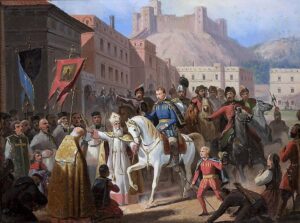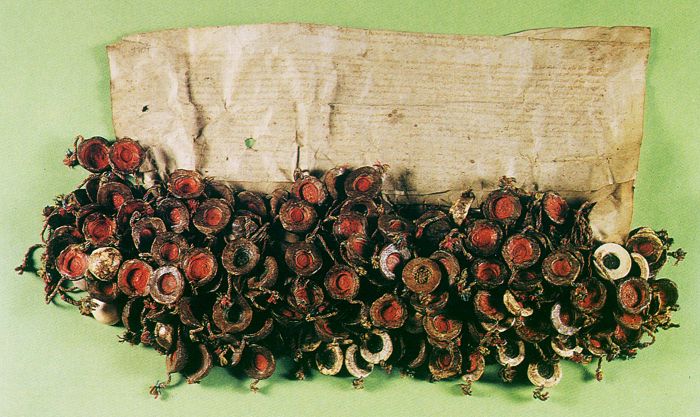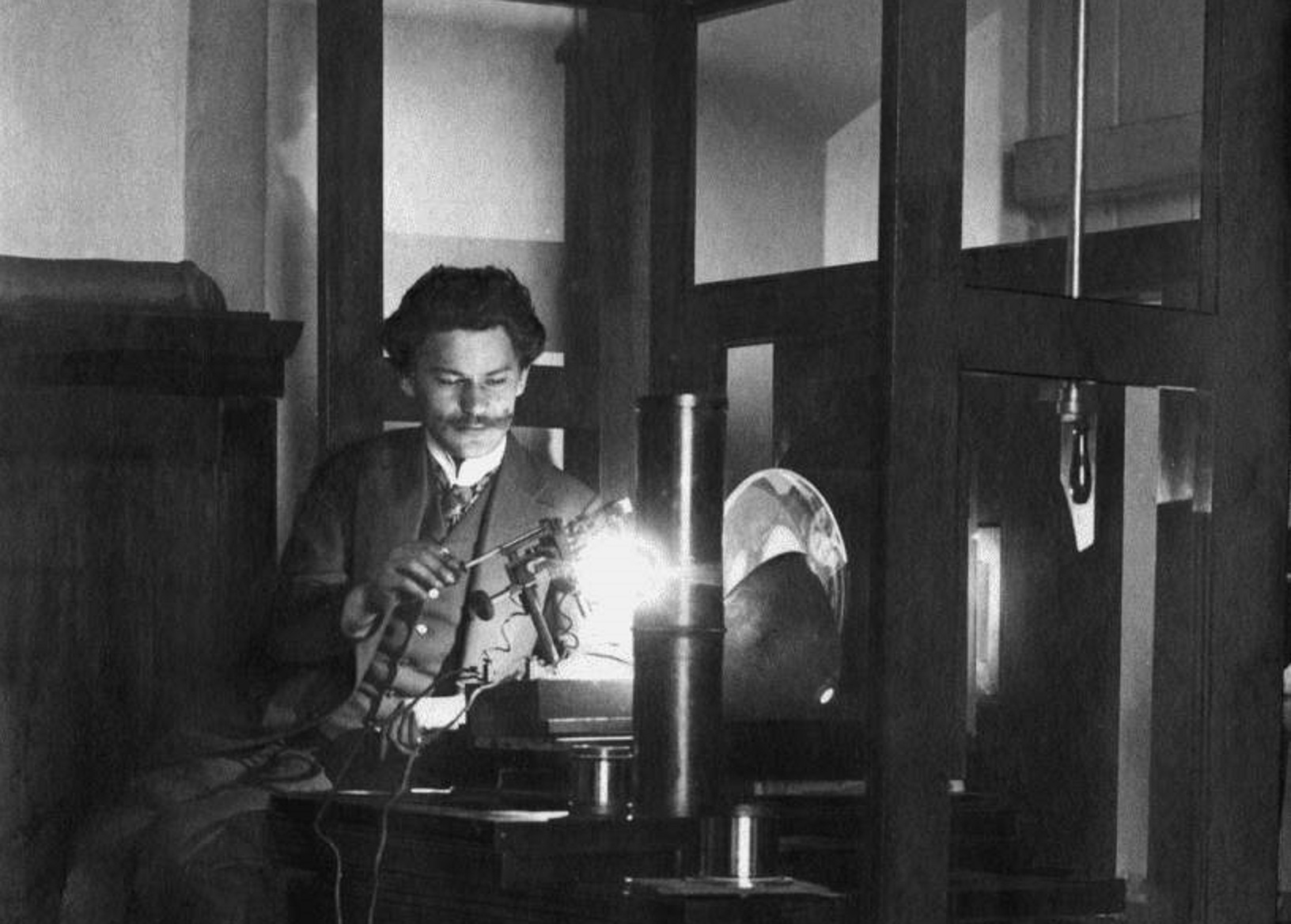On 31 October 1517 the theses of Martin Luther put an end to the medieval world. The religious unity of the past centuries was over, leaving room for new conflicts and problems in the future. One did not have to wait long for their arrival.
by Michał Rzeczycki
Centuries ago, it was believed that heresy was not simply one out of many views, but a negation of something that was obvious to the public at the time. If we add to this the fact that religious authority was charged with approving secular authority, we understand that the heretic was not just an intellectual or religious threat – a heretic was a threat to the entire social order. Although this last argument in the 16th Century was not always convincing, it contained a grain of truth. Suffice it to say, Germany, seven years after Martin Luther’s theses had been announced, suffered the largest peasant uprising in the history of the country, and it was guided by new religious ideas. Peasants, encouraged by the revolutionary interpretation of the Holy Scriptures, proclaimed, inter alia, the abolition of feudal relations and the abolition of the mediation of priests. This transition from private beliefs to public demands was by no means unique, and every secular authority felt compelled to react when some new religion refused to obey the law.

The Catholic Church responded to unorthodox religious speeches in accordance with the doctrine laid out by Thomas Aquinas (cf. Sth II-II, q. 11, a. 3). According to him, a heretic should be judged from two points of view: first, from their own point of view; secondly, from the point of view of the Church. A heretic himself, says Thomas Aquinas, is guilty of sins for which he should not only be excluded from the community of believers, but also, if so decided by the secular authority, should be removed from this world. Corruption of the faith was a far greater offense than counterfeiting money, and since secular authorities sentenced counterfeiters to death, this penalty was even more applicable to heretics. From the point of view of the Church, the heretic deserved to be treated gently and with mercy, which should be expressed in the form of admonitions. If the apostate disobeyed, then the Church should curse them and turn them over to secular authorities, that they may be removed from among the living. One cannot compromise the salvation of other believers by over-tolerating the existence of views contrary to the true faith.
These were the two basic premises, secular and clerical, which stood behind the hostility directed against religious upstarts. However, while the split in the Church was successfully suppressed by the time of Luther’s theses, the Reformation, nevertheless, spread throughout Europe thanks to the broad support of secular authorities. Some saw in Protestantism a chance for a purely temporal benefit, which was to break free from the bonds of dependence, e.g. towards the Roman Emperor. Many, however, were impatient and disgusted with the terrible intellectual and moral levels of the Catholic clergy of that time.
See more: Community builder: Jan Łaski (1499-1560). Peculiarities of the Reformation in the Polish-Lithuanian Commonwealth
The stakes were high while the dispute was on – it was all about salvation. Therefore, it was difficult to expect that the division of Western Christianity would take place without bloodshed. Religious wars in Europe began almost immediately, and all sides of the doctrinal dispute should be blamed for the burnings at the stake, as well as the persecution, exile and confiscation that followed. It is true that Catholics invented the inquisition and the episcopal courts, with the help of which they prosecuted and sentenced to death all those who refused to give in to the admonition of the clergy. It is also true that, for example, John Calvin defended the burning at stake of the anti-trinitarian Michael Servetus in Geneva. Moreover, John Calvin in the justification of this act went much further than Aquinas, recognizing that tolerating the very existence of an apostate would amount to at least partially acknowledging that he was right.
Further developments varied from country to country, but it could be argued each time that politics had legitimacy and supremacy over religion. Meanwhile, often at stake was the life of those, and their property, who professed a religion other than the dominant one. In this context, the act of the Warsaw Confederation adopted in 1573 is undoubtedly unprecedented, as it extended its legal scope of tolerance more extensively than anywhere else. How did it happen that, in the Polish–Lithuanian Commonwealth, a law was passed that guaranteed religious peace, while in the West, either the ruler converted to a new faith and began to persecute Catholics, as was the case of England, or defended the old order and bloodily suppressed all outbreaks of Protestantism, as in France?

First, the Polish–Lithuanian Commonwealth was already a multi-ethnic and multi-religious state. In the Crown of the Polish Kingdom, tolerance was extended to the Orthodox Church by King Casimir the Great immediately after joining Red Ruthenia in the mid-fourteenth century. The decision of the last ruler of the Piast dynasty was pragmatic. As the Teutonic Knights were against him and the Czechs had claimed the Polish crown, the last thing King Casimir needed was a conflict with the population of the newly joined province. Legal recognition of the social fact, i.e. the existence of a significant Orthodox minority in the state, was simply the most reasonable of possible moves.
This religious dualism became even stronger with the accession to the Polish throne of the Jagiellonian dynasty and with the union of the Crown with the Grand Duchy of Lithuania, which was basically entirely Orthodox. The only exception was the land of Samogitia, where the process of Christianization barely had begun. Pagan faith still dominated there in the south-eastern outskirts of Lithuania, and one could meet Muslims there. This colorful mosaic of faith would not be complete without the significant Jewish population in some cities. Such a complex social composition had its consequences; in Poland, the argument that the lack of religious unity was destroying the state was quite popular. The population of the Commonwealth, in particular the nobility, was mentally accustomed to the fact that within one political formation there were people of various religions and faiths, and yet the political community did not need to split.
Secondly, the nobility was a specific and unique community when compared to Europe. Proportionally to the general population, it was much more numerous than the community of knights in the West. In relation to France, they constituted about 2% of the population. In the Commonwealth, meanwhile, the nobility not only constituted about 8% of the entire population, but also it was a homogenous community. There were no counts or princesses within it, and even if they appeared, they were granted their titles by a foreign monarch, e.g. the Roman Emperor.

Numerous privileges, including a guarantee of personal and property immunity (the famous “neminem captivabimus nisi iure victum”) meant that any punishment for heresy was a fiction. Episcopal courts could, of course, be condemned, and the king could issue edicts stigmatising deviation from the Catholic faith. Each time, however, these acts remained either illegal or ineffective. Regarding private property, royal decisions could not be enforced. This was only possible within royal estates, but there the provincial royal officials (‘starosta’), who belonged to the nobility themselves, were not eager to exercise the new law. All this was done in the name of well-understood state solidarity. If the confiscation of property threatened a Protestant neighbour, a Catholic nobleman preferred to defend him in the name of civil liberty, rather than allow the establishment of new precedents. They did not want to enable the authorities of the country to rule over the life, property and conscience of the noble citizens of the Republic.
Among the legal peculiarities of the Polish-Lithuanian nobility, one cannot ignore the “Nihil novi” Constitution from 1505. The introduction of any new law depended on the consent of the Chamber of Deputies which was the third parliamentary state next to the king and senate. Therefore, if the king wanted to restore the exclusive rule of the Catholic religion with his sword, he would have to ask the Sejm (parliament) to pass an appropriate law. This, however, was impossible to achieve in a parliament that was divided between various sorts of Christians. None of them, in the name of their own interest, was willing to allow the persecution of any nobleman in the name of religious beliefs. As a result, legal and social acts forced compromise and a guarantee of religious peace.
See more: Sigismund II Augustus: a Renaissance portrait of a melancholic man
With the arrival of the Reformation to Poland, the nobility converted en masse to Lutheranism or Calvinism. This does not mean that the nobility lacked piety or religiousness. The motives for the conversion were usually much more prosaic. They had their origin in the endless dispute between the nobility and the clergy, beginning in the mid-15th Century, which lasted until the end of the Polish-Lithuanian Commonwealth. The thorn in the knights’ side was the extensive authority of the clergy, as also tithes or bequests for the Church were under their control. These were things that had little to do with guiding human souls towards salvation. To top it all off, the clergy consistently avoided giving away part of their income for the defense of the state. For a nobleman, converting to Protestantism was simply a way of expressing their antagonism. It was much easier to argue with Catholic clergy without being subject to the episcopal courts.
Between 1517 and 1572, the last two monarchs of the Jagiellonian dynasty ruled the country. It was highly significant, as both of these rulers were tolerant by their very nature. Sigismund I definitely did not like to use violence, although when necessary he used it consistently. Just as it happened in relation to the Gdansk Uprising, or Gdansk Rebellion of 1525 (“Tumult gdański”), when Lutherans wanted to force a new social order on the city. Although the new authorities sent letters to the king assuring their loyalty and obedience, no secular authority could allow violent political changes. Therefore, King Sigismund I came down to the city walls with an army of 8,000. At the sight of him, the Lutherans of Gdansk, as the local merchant described, were so afraid that “not only in God, but also in a donkey they would believe.”

Sigismund II Augustus, the successor of Sigismund I, had in practice a similar attitude to tolerating people of other beliefs in his country. Although he was far from his father’s piety, he was intelligent enough to know what it would mean for the Commonwealth if he forced heretics to convert. For this reason, he consistently disregarded the arguments of the nuncio Giovianni Francesco Commendone who tried to convince the king that those who had obeyed God would certainly soon obey the ruler as well. Sigismund II Augustus was not very convinced. He was sure, however, that consenting to the nuncio would lead to a civil war. Foreign countries provided him already with too many examples of civil wars.
The fact that Sigismund II Augustus died without issue and the events in Europe were the reasons for the adoption of the Warsaw Confederation Act. On 7 July 1572 the last of the Jagiellonians died in Knyszyn, and it was unclear who the next king should be. Nor was it certain how the new monarch should be elected. It could turn out that the future ruler would not be tolerant at all and would try to force his subjects to converst. This was a serious concern, as one of the most serious candidates for the Polish-Lithuanian throne was the brother of the King of France, Henry of Valois, who from 11 February to 26 June besieged the Huguenots’ fortress of La Rochelle. The Polish delegation, which went to France to negotiate the candidacy of Henry for the King of Poland and Grand Duke of Lithuania, encountered plenty of devastated villages in ashes and starving people. This sad view, of which the nobility of the Polish-Lithuanian Commonwealth was aware (the anti-French propaganda of the Habsburgs was helpful in this), had a vivid effect on their imagination. However, the event that coalesced all the terror of the religious feuds was the famous night between the 23-24 August 1572, commonly known as St. Bartholomew or the Vespers of Paris. Around five thousand French Protestants were murdered on the streets of Paris and outside the city. In this way, the Polish-Lithuanian nobility understood they should not follow the French example, as it was proof of what can happen when the state resigns from its principles of religious peace.

On 28 January 1573, the act of the Warsaw Confederation was adopted. Signatories, both Catholics and Christians, of other confessions, agreed, inter alia, that:
“any ruler should not be approved, unless under the agreement: that all our rights, privileges and liberties would be granted to us, that we would present to him post electionem, and he was to swear to consent to them. He would namely have to approve of: a common peace between people of various faiths and let them keep their devotion and not to force us to go abroad and never drag us by any custom or royal request, nor by solucione quinque mar-carum super hastam, nor to decree the levée en masse without a parliamentary resolution”.
The legal act thus formulated was presented to Polish-Lithuanian King Henry, and became part of the Henrician Articles, (Known in Polish as the Artykuły Henrykowskie, a statement of the rights and privileges of the Polish gentry), which had to be approved by the newly elected ruler. During the coronation of Henry on 21 February 1574, a riot took place in which Grand Marshal of Poland Jan Firlej was involved. He interrupted the ceremony and demanded from the king-elect that he, as a king, would respect the rights of Protestants. Henry III, wishing to rule the Commonwealth, had to agree to the principles of religious peace.

The history of the Warsaw Confederation did not end, of course, with the mere passing of the law. Nor can it be said that nobody in Poland before or after was killed for religious beliefs, nor that any temple was burned down, nor anyone was harmed for being considered a heretic. The issue of the rights of townspeople, whose religious freedom essentially depended on the city’s status, remained controversial. Even more complex was the situation of the peasants, to whom the noble lords often applied the principle of “cuius regio, eius religio” and thus ordered them to convert.
On the other hand, there were situations when the nobles defended a townsman who was to be condemned to death for heresy. There were also speeches by the noblemen in defense of the peasants, for example by Piotr Zborowski, who believed that knighthood had no right to impose religious beliefs on peasants. Despite all these ambiguities, the Warsaw Confederation proved that the status of Catholicism as the ruling religion in Poland does not mean that the secular authorities intended to force anybody to convert.
See more: Mobs or Citizens: Who Chose the Leaders of the Polish Republic?
In Europe, pluralism was defeated by the state or there was a demand for a neutral state. In the entire spectrum of solutions to this problem, the resolution of the Warsaw Congress of 28 January 1573, appears as a right and balanced solution between extremes. According to its principles, it is possible to reconcile the state, as it was shaped by history, with the freedom of belief. In defense of the latter, Sir Thomas More lost his head by King’s Henry VIII order. In Poland, however, it was possible to introduce the kings to the concept of tolerance as Marshal Firlej did: “Et nunc nisi id feceris, rex in Polonia non eris”, meaning: “If you do not approve of it right now, you cannot be a king of Poland anyhow”.
Author: Michał Rzeczycki
Translation: Alicja Rose & Jessica Sirotin





